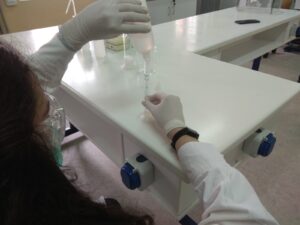News . Best Practices The “cycle” of plastic

This good practice presents an open schooling initiative on “Plastics and Food”, developed by the 4th High School of Serres and the chemistry teacher Bazouki Evaggelia, from 01/02/2022 to 20/05/2022. The implementation of the educational scenario was organized in the e-class, where the instructions, worksheets, a shared document, a shared photo-video album and useful research web links were posted.
Three scientists participated in the activities: from the Department of Materials Science and Technology of the University of Crete, from the Department of Chemistry of the Aristotle University of Thessaloniki and from the Hellenic Centre for Marine Research. A professional from the recycling sector also contributed.
For the meetings with the experts we collaborated with another part of our school that was implementing a multimedia-related scenario.
It was supported by the Regional Directorate of Primary and Secondary Education of Crete. This practice was previously presented on the CONNECT platform.
Care: The students addressed a real problem, which is the impact of plastics on the food they come into contact with and thus on our health, and their presence as microplastics in the food chain. They were concerned about the amount of plastic they use at individual and family level in terms of food and recorded it in a shared document. The labelling of plastics was another interesting element to investigate. They were interested in the fate of plastics after use, both in the disposal sites and in the recycling sites. Also, the possibility of replacing them with other less harmful materials.The students who participated in the activities belonged to a class of 22 students in the second grade of high school, aged 16-17 years old.
Know: Students used chemistry knowledge about polymers, both artificial and natural. The technology of plastics is not taught in school and so students are not aware of the problems associated with their safe use. Thus, through the project, they investigated the safety of plastics in terms of their use in food packaging and storage (the material to be studied accompanying the scenario was posted on eclass).
They produced a bioplastic from a potato (following research) and investigated the role of the plasticiser. They filmed the experiment and entered it into an official competition of video experiments (PANECFE). They also tried to produce bioplastic from milk. They simulated a plastic recycling plant (sorting by type of plastic using special labelling). They proposed an experimental test to determine the type of unlabelled plastic, following research.
They worked in groups to investigate microplastics (sources, shape, size, airborne dispersion) using an online activity and a prototype worksheet. They studied recent articles on the detection of microplastics in the human body. To resolve questions and obtain additional information they contacted research scientists via videoconferencing.
The skills the students practiced were:
- searching, evaluating and using information from the internet
- scientific methodology (hypothesis, experiment, conclusion) – design and implementation of an experiment
- critical thinking
- decision-making after discussion
- cooperation with peers within the programme and other European school programmes (Erasmus+ , European Parliament Ambassador School Programme)
- communication with scientists
- synthesis of opinions and formulation of proposals
- digital creation
- the use of collaborative digital tools
- linking academic knowledge to everyday life.
Do: In the end, the students prepared
- a podcast on the European School Radio platform about the project (in cooperation with our school’s Erasmus+ programme)
- a proposal which they submitted to the Future of Europe Conference (Objective: Sustainable Development – Health and Well-being) and to the Ministry of Education and Religious Affairs’ conference simulation platform (in cooperation with the European EPAS programme)
- an information leaflet on the correct use and disposal of plastics, for distribution to families and schools
- poster on the creation and impact of microplastics, to be displayed in schools
- presentation for participation in the National Student Conference CONNECT 2022.
Note: all relevant documents and links are posted on the CONNECT platform Completed the activities as a team and supported by the families, the school’s management and the Teachers’ Association
Conclusions on Open Schooling: The activity was integrated into the curriculum. The proposed scenario was enriched with additional activities following the students’ interests and current events (see microplastics). It was extremely useful and innovative, combining research – communication with scientists – collaboration with European school projects – creation, highlighting a problem of everyday life that is not directly perceived and quite prominent (creation and presence of microplastics). Open schooling can be useful for other teachers because it enables them to open up educational horizons. They do not remain attached to the textbook and curriculum but are able to explore topics of everyday interest developing scientific thinking in students.
The change/innovation was supported by:
[ x ] School management [ x ] school association/network
[ x ] Local government [ ] Other: ________________________________
Student results: The students were very pleased with the opportunity to meet scientists and get information from them. Their participation in every kind of creation (experiment, poster, podcast…) excited them. By the end of the project they were more confident in presenting and scientifically supporting their knowledge. As an example, a student with a low communication profile claimed his participation in the CONNECT Student Conference, worked diligently to prepare for it and represented our team deservedly.
This practice contributed to the increase of:
[ x ] engaging families with sciences [ x ] involving girls in science [ x ] raising awareness among students about careers in the natural sciences
Please specify: Families were actively involved in the first stage, helping to identify the link between plastics and food and the problem they pose. The children’s mothers and their brothers and sisters were mainly involved. The girls made up the vast majority of the class and were very enthusiastic during the project. Of these, most will pursue Science Studies.